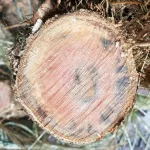The least-virulent strain of Rapid ʻŌhiʻa Death (ROD) was detected late last month in three landscape ʻōhiʻa trees on the campus of a Maui elementary school.
A Rapid Response Plan was implemented by the DLNR Division of Forestry and Wildlife (DOFAW) and the Maui Invasive Species Committee (MISC) which outlined notification steps regarding the positive test for ‘huli ʻōhiʻa, the less-serious of the two strains of ROD.
MISC and DOFAW crews removed the ʻōhiʻa trees from the campus yesterday. All cut stumps were treated and sealed. On-site burning was not an option due to the proximity of the elementary campus to surrounding homes. All green debris was collected in garbage bags for proper disposal.
MISC collected samples from nearby ʻōhiʻa trees as part of its follow-up monitoring and precautionary measures.
The two fungal species known as ROD were first found killing trees on Hawai‘i Island more than 10 years ago. They infect ‘ōhi‘a through open wounds on the bark and grow inside until all vessels transporting water throughout the tree are blocked, causing the leaves to quickly brown and die, hence the name Rapid ‘Ōhi‘a Death. Huli ‘ōhi‘a is the slower-growing of the two fungi species – a tree may be infected for some time before its noticed.
Maui has the state’s second largest population of ‘ōhi‘a, roughly 80,000 acres, and most are in State Forest Reserves, protected with fencing to keep grazing animals out.
Studies on Hawai‘i Island show that wild pigs, goats and deer continuously damaging wood dramatically increases ROD in unfenced areas.
People can help protect ʻōhiʻa forests, which are critical to watershed protection, with the following actions:
• Avoid injuring ʻōhiʻa: Open wounds on ʻōhiʻa are an entry point for disease spores. The disease can also spread from tree to tree on machetes or other tools.
• Don’t transport ʻōhiʻa interisland: It is illegal to move any part of an ʻōhiʻa between islands. Merrie Monarch participants are asked to honor the sacredness of ‘ōhi‘a by using other native plant materials in lei or offerings.
• Don’t move ʻōhiʻa wood or vegetation: Especially from areas known to have ROD.
• Clean hiking boots/gear/tools: Before hiking or entering a wooded area, scrub off all dirt and spray boot soles and tools with 70% rubbing alcohol. Wash your clothes in hot water and use a dryer to ensure the disease is not spread on boots and clothing.
• Wash your vehicle: If driving near ʻōhiʻa forests. The disease can remain alive and infectious in soil, so wash all dirt off vehicles.
Photo credit: DLNR
